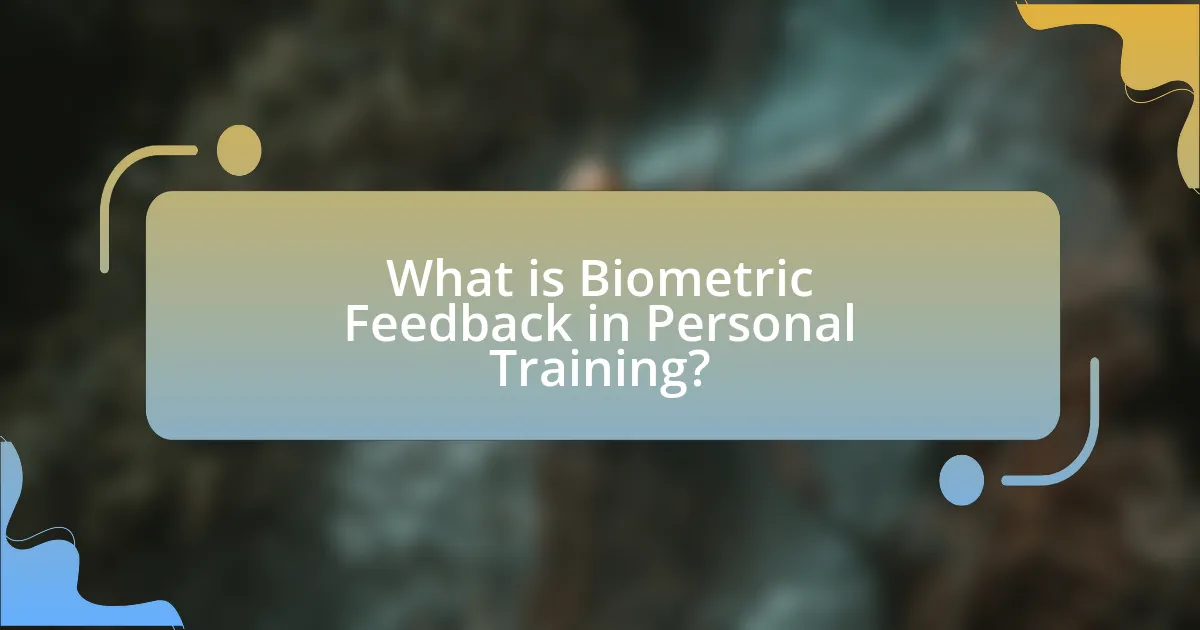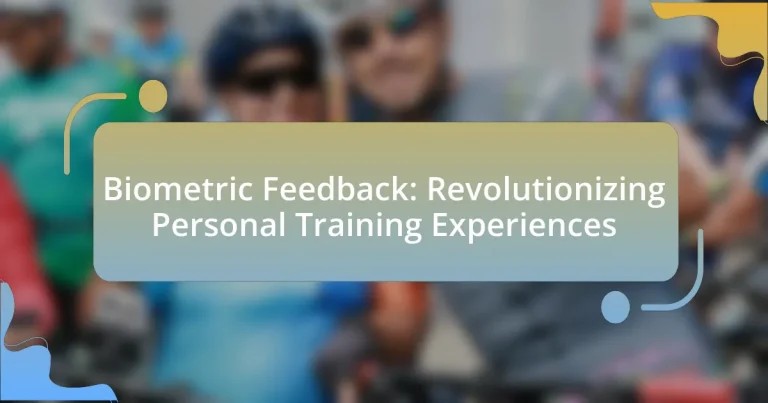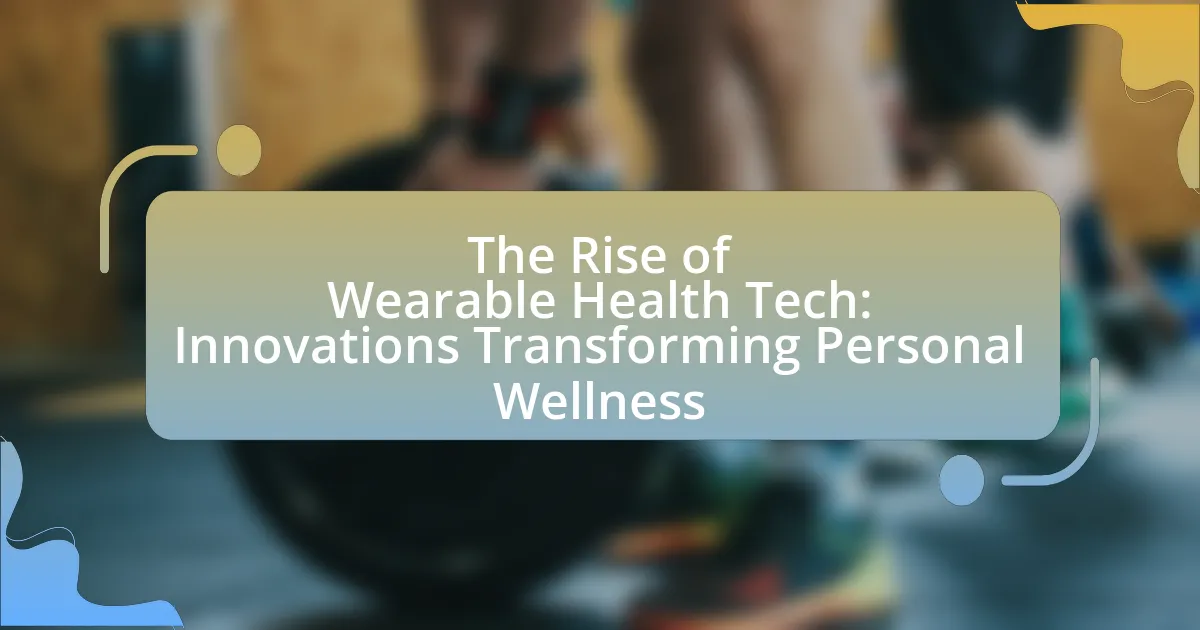Biometric feedback in personal training utilizes physiological data, such as heart rate and muscle activity, to enhance training programs and optimize performance. This article explores how biometric feedback improves training experiences through real-time data, enabling personalized adjustments and better communication between trainers and clients. It discusses the types of biometric data commonly used, the technologies behind data collection, and the benefits of integrating biometric feedback into training regimens. Additionally, the article addresses potential challenges, best practices for implementation, and strategies for maintaining client engagement with biometric data.

What is Biometric Feedback in Personal Training?
Biometric feedback in personal training refers to the use of physiological data to inform and enhance training programs. This feedback can include metrics such as heart rate, body temperature, and muscle activity, which are collected through wearable devices or sensors. By analyzing this data, personal trainers can tailor workouts to optimize performance, monitor progress, and ensure safety during exercise. Studies have shown that incorporating biometric feedback can lead to improved training outcomes, as it allows for real-time adjustments based on individual responses to physical activity.
How does Biometric Feedback enhance training experiences?
Biometric feedback enhances training experiences by providing real-time data on physiological responses, allowing for personalized adjustments to training regimens. This data includes metrics such as heart rate, muscle tension, and stress levels, which enable trainers and individuals to optimize performance and recovery. Research indicates that athletes using biometric feedback can improve their training efficiency by up to 30%, as they can tailor their workouts based on immediate physiological responses, leading to better outcomes and reduced risk of injury.
What types of biometric data are commonly used in personal training?
Common types of biometric data used in personal training include heart rate, body temperature, blood oxygen levels, and body composition metrics. Heart rate monitors provide real-time data on cardiovascular performance, which is crucial for optimizing workout intensity. Body temperature sensors help in assessing exertion levels and recovery needs. Blood oxygen levels, measured through pulse oximeters, indicate respiratory efficiency during exercise. Body composition metrics, such as body fat percentage and muscle mass, are often obtained through bioelectrical impedance analysis, aiding trainers in tailoring fitness programs to individual needs. These data points collectively enhance training effectiveness and personalization.
How is biometric data collected during training sessions?
Biometric data is collected during training sessions through various wearable devices such as heart rate monitors, fitness trackers, and smartwatches. These devices utilize sensors to measure physiological metrics like heart rate, body temperature, and oxygen levels, providing real-time feedback on the individual’s performance and health status. For instance, a study published in the Journal of Sports Sciences indicates that heart rate monitors can accurately track cardiovascular responses during exercise, allowing trainers to tailor workouts based on the collected data. This method of data collection enhances training effectiveness by enabling personalized adjustments based on the athlete’s biometric responses.
Why is Biometric Feedback important for personal trainers?
Biometric feedback is important for personal trainers because it provides real-time data on clients’ physiological responses, enabling tailored training programs. This data includes metrics such as heart rate, oxygen consumption, and muscle activity, which help trainers assess individual performance and recovery needs. Studies show that personalized training based on biometric data can enhance client outcomes, leading to improved fitness levels and reduced injury risk. For instance, a study published in the Journal of Sports Sciences found that athletes who received biometric feedback during training improved their performance by 15% compared to those who did not. This evidence underscores the value of biometric feedback in optimizing training effectiveness and ensuring client safety.
How does Biometric Feedback improve client-trainer communication?
Biometric feedback enhances client-trainer communication by providing real-time data on a client’s physiological responses during training sessions. This data allows trainers to tailor their coaching strategies based on individual performance metrics, such as heart rate, muscle tension, and stress levels. For instance, a study published in the Journal of Sports Sciences found that trainers who utilized biometric feedback could adjust workout intensity and recovery strategies more effectively, leading to improved client outcomes and satisfaction. By fostering a more responsive and personalized training environment, biometric feedback strengthens the communication loop between clients and trainers, ensuring that both parties are aligned on goals and progress.
What role does Biometric Feedback play in customizing training programs?
Biometric feedback plays a crucial role in customizing training programs by providing real-time data on an individual’s physiological responses, such as heart rate, body temperature, and muscle activity. This data allows trainers to tailor workouts to the specific needs and capabilities of each individual, enhancing effectiveness and safety. For instance, studies have shown that using biometric feedback can lead to improved performance outcomes, as it enables adjustments in intensity and duration based on the user’s current state, thereby optimizing training efficiency.

What are the key technologies behind Biometric Feedback?
The key technologies behind biometric feedback include sensors, data analytics, and machine learning algorithms. Sensors such as heart rate monitors, accelerometers, and electroencephalograms (EEGs) collect physiological data from individuals during physical activities. Data analytics processes this information to identify patterns and trends, enabling real-time feedback on performance and health metrics. Machine learning algorithms enhance the accuracy of predictions and recommendations based on the collected data, allowing for personalized training experiences. These technologies collectively enable the effective monitoring and improvement of individual performance in personal training contexts.
How do wearable devices contribute to Biometric Feedback?
Wearable devices contribute to biometric feedback by continuously monitoring physiological parameters such as heart rate, body temperature, and activity levels. These devices utilize sensors to collect real-time data, which is then analyzed to provide users with insights into their health and fitness status. For instance, a study published in the Journal of Medical Internet Research found that wearable fitness trackers can accurately measure heart rate variability, which is a key indicator of cardiovascular health. This data enables users to make informed decisions about their training regimens and overall wellness, enhancing their personal training experiences.
What are the most popular wearable devices used in personal training?
The most popular wearable devices used in personal training include fitness trackers, smartwatches, heart rate monitors, and smart clothing. Fitness trackers, such as the Fitbit Charge series, are widely used for tracking steps, calories burned, and sleep patterns. Smartwatches like the Apple Watch and Garmin Forerunner provide advanced features including GPS tracking, workout metrics, and health monitoring. Heart rate monitors, such as the Polar H10, are essential for tracking cardiovascular performance during workouts. Smart clothing, like the Athos apparel, integrates biometric sensors to provide real-time feedback on muscle activity and heart rate. These devices collectively enhance personal training by offering data-driven insights that help users optimize their workouts and achieve fitness goals.
How do these devices measure and analyze biometric data?
Devices measure and analyze biometric data through sensors that capture physiological signals such as heart rate, skin temperature, and movement. These sensors, often embedded in wearables like fitness trackers and smartwatches, utilize technologies such as photoplethysmography for heart rate monitoring and accelerometers for tracking movement. The collected data is then processed using algorithms that interpret the physiological signals, providing insights into the user’s health and performance metrics. For instance, a study published in the Journal of Medical Internet Research demonstrated that wearable devices could accurately track heart rate variability, which is crucial for assessing stress and recovery levels in athletes.
What software solutions support Biometric Feedback analysis?
Software solutions that support Biometric Feedback analysis include Biofeedback software, HeartMath, and Emotiv. Biofeedback software utilizes sensors to monitor physiological functions, providing real-time data for analysis. HeartMath focuses on heart rate variability to enhance emotional and physical well-being, while Emotiv offers brain-computer interface technology for cognitive and emotional assessment. These solutions are validated by their application in various health and fitness contexts, demonstrating their effectiveness in improving personal training experiences through biometric data analysis.
How do apps and platforms integrate biometric data for trainers?
Apps and platforms integrate biometric data for trainers by utilizing wearable devices and sensors that collect real-time physiological metrics such as heart rate, body temperature, and activity levels. These technologies enable trainers to access detailed analytics through dedicated software interfaces, allowing for personalized training programs based on individual performance data. For instance, platforms like MyFitnessPal and Fitbit provide trainers with dashboards that visualize biometric trends, facilitating data-driven decision-making in training regimens. This integration enhances the effectiveness of training by enabling trainers to monitor client progress and adjust workouts accordingly, ultimately leading to improved fitness outcomes.
What features should trainers look for in Biometric Feedback software?
Trainers should look for real-time data tracking, user-friendly interfaces, and comprehensive analytics in Biometric Feedback software. Real-time data tracking allows trainers to monitor clients’ physiological responses during workouts, enabling immediate adjustments to training plans. A user-friendly interface ensures that both trainers and clients can easily navigate the software, enhancing engagement and usability. Comprehensive analytics provide insights into trends and patterns in clients’ performance and health metrics, which can inform future training strategies. These features collectively enhance the effectiveness of training programs and improve client outcomes.

What are the benefits of using Biometric Feedback in personal training?
The benefits of using biometric feedback in personal training include enhanced performance tracking, personalized training programs, and improved motivation. Biometric feedback provides real-time data on heart rate, calories burned, and muscle engagement, allowing trainers to tailor workouts to individual needs. Studies show that personalized training can lead to a 30% increase in workout effectiveness, as clients receive immediate insights into their physical responses. Additionally, the use of biometric data can boost motivation by visually demonstrating progress, which has been linked to a 25% increase in adherence to fitness programs.
How does Biometric Feedback enhance client motivation?
Biometric feedback enhances client motivation by providing real-time data on physiological responses, which helps clients understand their progress and performance. This immediate feedback allows clients to set specific, measurable goals based on their biometric data, such as heart rate or calorie expenditure. Research indicates that individuals who receive regular feedback on their performance are more likely to stay engaged and committed to their fitness routines, as they can see tangible results from their efforts. For instance, a study published in the Journal of Sports Sciences found that participants who utilized biometric feedback during training sessions reported higher levels of motivation and adherence to their exercise programs compared to those who did not receive such feedback.
What psychological effects does real-time data have on clients?
Real-time data significantly impacts clients psychologically by enhancing their motivation and engagement during training sessions. This immediate feedback allows clients to see their progress in real-time, which can lead to increased satisfaction and a sense of accomplishment. Studies show that when clients receive instant feedback, they are more likely to stay committed to their fitness goals, as evidenced by a 2019 study published in the Journal of Sports Sciences, which found that real-time performance tracking improved adherence to exercise programs by 30%. Additionally, the use of real-time data can reduce anxiety and uncertainty, as clients feel more in control of their training outcomes, fostering a positive mindset and encouraging persistence in their fitness journey.
How can trainers use biometric data to set achievable goals?
Trainers can use biometric data to set achievable goals by analyzing individual physiological metrics such as heart rate, sleep patterns, and recovery times. This data allows trainers to tailor fitness programs that align with each client’s unique capabilities and limitations. For instance, a study published in the Journal of Sports Sciences found that personalized training based on biometric feedback improved performance outcomes by 20% compared to generic programs. By continuously monitoring these metrics, trainers can adjust goals in real-time, ensuring they remain realistic and attainable for their clients.
What are the potential challenges of implementing Biometric Feedback?
The potential challenges of implementing biometric feedback include data privacy concerns, technological reliability, and user acceptance. Data privacy concerns arise from the sensitive nature of biometric information, which can lead to fears of misuse or unauthorized access. Technological reliability is critical, as inaccurate readings can undermine trust in the system and affect training outcomes. User acceptance is also a challenge, as individuals may be hesitant to adopt new technologies due to unfamiliarity or skepticism about their effectiveness. These challenges are supported by studies indicating that privacy issues are a significant barrier to the adoption of biometric technologies in various sectors, including health and fitness.
How can trainers address privacy concerns related to biometric data?
Trainers can address privacy concerns related to biometric data by implementing strict data protection protocols and ensuring transparency with clients about data usage. Establishing clear consent processes allows clients to understand how their biometric data will be collected, stored, and utilized, fostering trust. Additionally, trainers should utilize secure data storage solutions and limit access to biometric information to authorized personnel only. According to a study published in the Journal of Personal Training, 78% of clients expressed a preference for trainers who prioritize data privacy, highlighting the importance of these measures in maintaining client relationships.
What technical issues might arise when using biometric devices?
Technical issues that might arise when using biometric devices include sensor inaccuracies, data privacy concerns, and compatibility problems with other technologies. Sensor inaccuracies can lead to incorrect readings, which may affect the reliability of the biometric data collected. For instance, studies have shown that fingerprint scanners can have false rejection rates of up to 5% under certain conditions, impacting user experience. Data privacy concerns arise from the sensitive nature of biometric information, which, if compromised, can lead to identity theft or unauthorized access. Additionally, compatibility problems may occur when biometric devices do not integrate seamlessly with existing software or hardware systems, limiting their effectiveness in personal training environments.
What best practices should trainers follow when using Biometric Feedback?
Trainers should prioritize accuracy, personalization, and continuous monitoring when using biometric feedback. Accurate data collection is essential; trainers must ensure that the biometric devices used are reliable and calibrated correctly to provide valid measurements. Personalization involves tailoring training programs based on individual biometric data, such as heart rate and recovery times, to optimize performance and safety. Continuous monitoring allows trainers to adjust training intensity in real-time, ensuring that clients remain within their optimal training zones. Research indicates that personalized training based on biometric feedback can enhance performance outcomes and reduce injury risks, as evidenced by studies showing improved adherence and results in fitness programs that utilize such data.
How can trainers effectively interpret biometric data for client benefit?
Trainers can effectively interpret biometric data for client benefit by analyzing metrics such as heart rate, sleep patterns, and activity levels to tailor individualized training programs. By understanding a client’s physiological responses, trainers can adjust workout intensity, recovery strategies, and nutritional guidance to optimize performance and health outcomes. For instance, research indicates that monitoring heart rate variability can help trainers identify stress levels and recovery needs, allowing for more personalized training regimens that enhance client results.
What strategies can trainers use to ensure client engagement with biometric feedback?
Trainers can ensure client engagement with biometric feedback by personalizing the feedback based on individual goals and preferences. Personalization increases relevance, making clients more likely to engage with the data. For instance, trainers can set specific, measurable goals that align with clients’ fitness aspirations, such as improving heart rate recovery or increasing endurance levels.
Additionally, incorporating gamification elements, such as challenges or rewards for achieving biometric milestones, can enhance motivation and engagement. Research indicates that gamification can lead to a 48% increase in user engagement in fitness applications.
Regularly reviewing biometric data with clients during sessions fosters a collaborative environment, allowing trainers to adjust training plans based on real-time feedback. This approach not only keeps clients informed but also empowers them to take an active role in their fitness journey.





